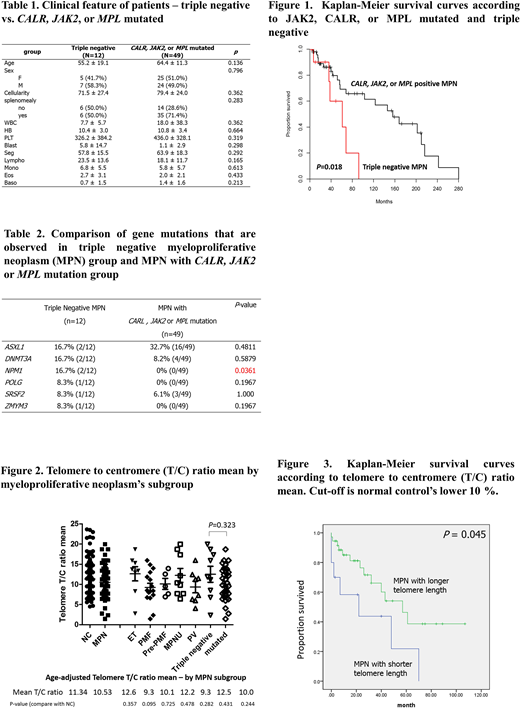Abstract
Background: We compared the clinical, cytogenetic, molecular features, and telomere lengths of patients with triple negative MPN and MPN with any of CALR, JAK2 or MPL mutations.
Methods: Target capture sequencing of 87 genes and molecular cytogenetic studies were performed in 61 Korean patients with MPN. Also, we searched the newly reported mutations and novel mutations in triple negative MPN [JAK2-G335D (germline), JAK2-F556V, JAK2-G571S (germline), JAK2-V625F (germline), MPL-T119I, MPL-S204F/P, MPL-E230G, MPL-V285E (germline), MPL-R321W (germline), MPL-Y591D, MPL-S505N and MPL-W515R]. We compared clinical and molecular characteristics between two groups. Additionally, we performed telomere quantitative FISH for 48 patients' samples and measured telomere/centromere ratios of them.
Results: Among 61 patients, 13 patients showed mutations in CALR, 34 in JAK2, and 3 in MPL. All of JAK2 mutation and CALR mutation site were reported sites, but 2 among 5 mutation site of MPL were novel mutation [D128N, D261Y]. Twelve patients showed triple negative (7 of PMF 7, 2 of ET, and 3 of MPN-U) - they showed 8 different mutation sites among 6 different genes (ASXL1, DNMT3A, NPM1, POLG, SRSF2, and ZMYM3). NPM1, POLG, and ZMYM3 mutations were seen only in triple negative patients. NPM1 mutation was significantly higher in triple negative MPN (P=0.0301). In telomere length study, there was no statistical difference between triple negative group (T/C ratio mean 12.5) and CALR, JAK2 or MPL mutated group (T/C ratio mean 10.0). Although, MPN patients with telomere length shorter than normal control's lower 10% (7.04) showed poor prognosis (P=0.0045).
Conclusions: Patients with triple negative MPN are characterized by high frequency of NPM1 mutation and less number of somatic mutations. Since the mutational analysis for diagnostic purposes is limited to exons 14 of JAK2, exon 10 of MPL and exon 9 of CALR at present, search for JAK2 and MPL mutations in other sites are essential in triple negative MPNs.
Keywords: Myeloproliferative neoplasms, next-generation sequencing, triple negative MPN, chromosome, FISH, telomere
No relevant conflicts of interest to declare.
Author notes
Asterisk with author names denotes non-ASH members.


